Dylan & Obama
Speaking in Tongues
And they were all filled with the Holy Ghost, and began to speak with other tongues, as the Spirit gave them utterance. […]
And it shall come to pass in the last days, saith God, I will pour out of my Spirit upon all flesh: and your sons and your daughters shall prophesy, and your young men shall see visions, and your old men shall dream dreams.
Acts 2:4 & 17
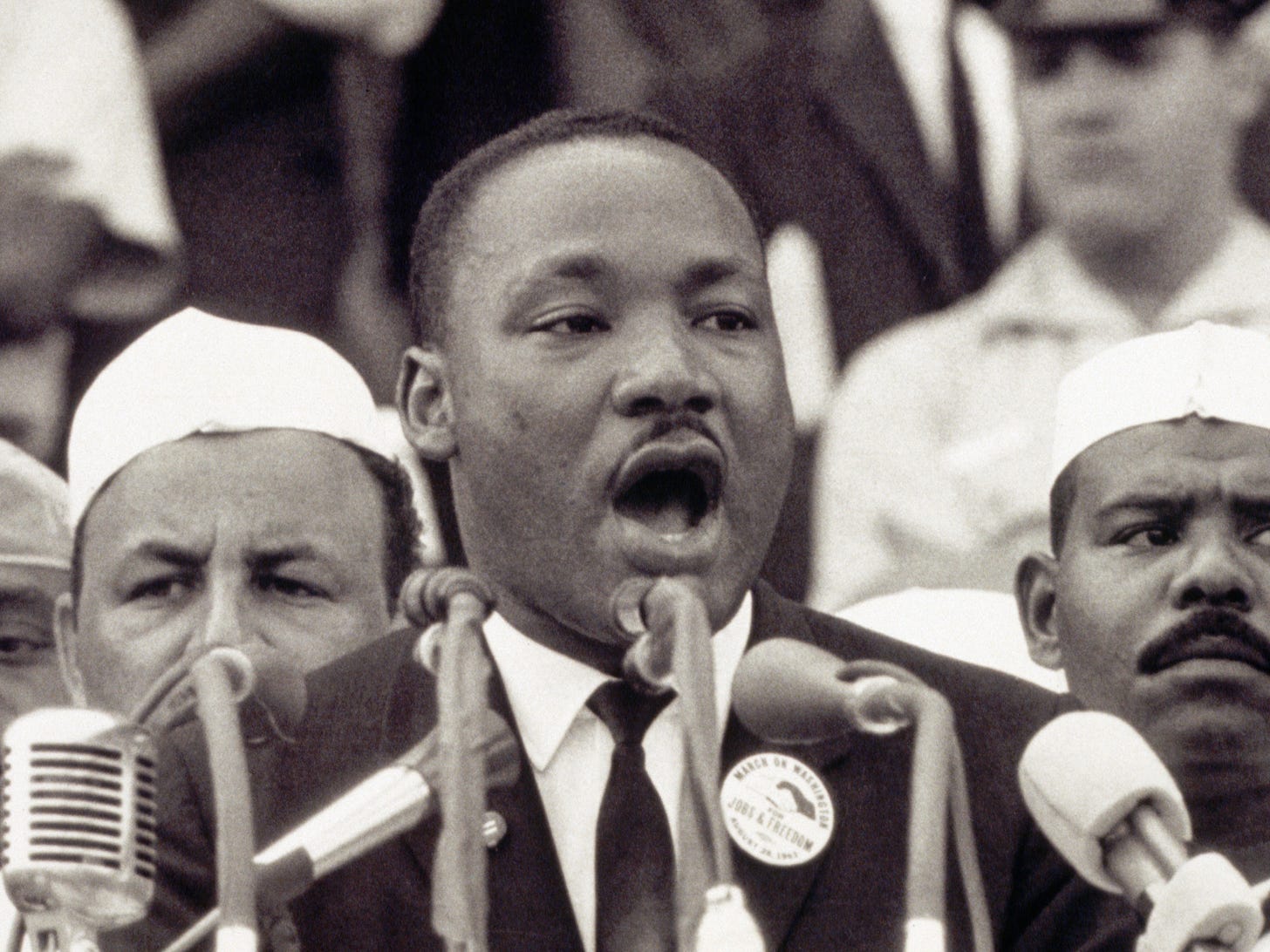
I started writing this piece on Martin Luther King Day 2023. Readers of Shadow Chasing will know that Dylan took part in the March on Washington in 1963, singing a few songs from the steps of the Lincoln Memorial before King’s epoch-defining “I Have a Dream” speech. Decades later in the documentary No Direction Home, Dylan recalled that historic day: “I was up close when King was delivering that speech. To this day it still affects me in a profound way.”
Today I want to reflect upon Dylan’s relationship with another major African American leader: Barack Obama. The future 44th President of the United States was only two years old when his heroes John Lewis and Martin Luther King galvanized the civil rights movement with their inspirational speeches at the March on Washington. A generation later he was motivated by their example to get involved in community organization and political activism. The title of his first book, Dreams from My Father: A Story of Race and Inheritance (1995), ostensibly refers to the aspirations of his biological father; but on other levels, his inheritance clearly includes other dreams from other adopted fathers.
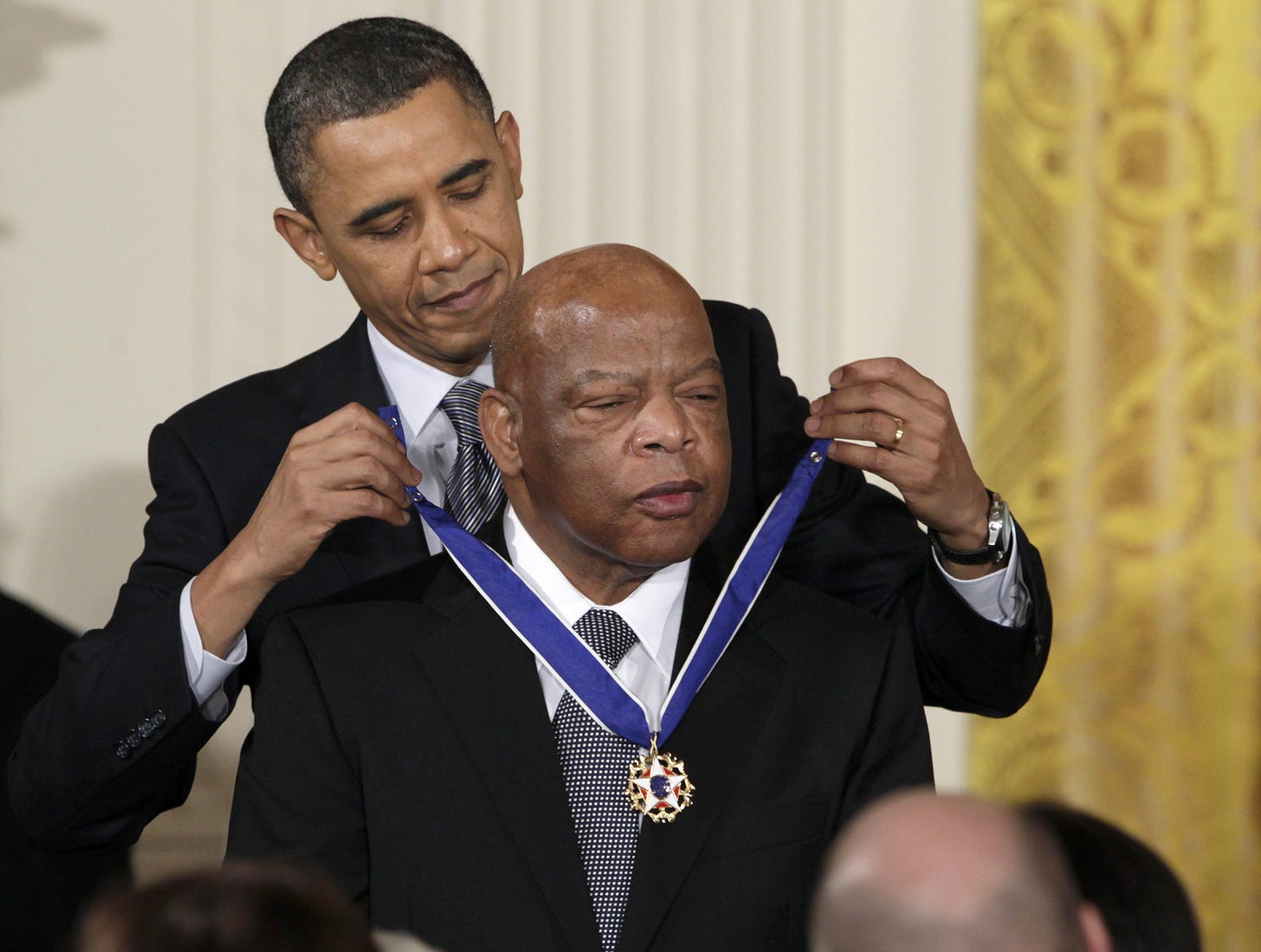
Obama has repeatedly signaled that he is a big Dylan fan, and Dylan is on record affirming his admiration for Obama. The two have more in common than you might expect, and I think we can gain deeper appreciation of both by putting their work in conversation. My deep immersion in The Philosophy of Modern Song is teaching me how to think in threes with Dylan, specifically by seeking out middle figures who mediate between seeming opposites. Zadie Smith suits this purpose well for the present piece. My title is borrowed from her essay “Speaking in Tongues,” first delivered as a lecture at the New York Public Library in December 2008, a month after Obama’s election. Her title alludes to the President-Elect’s special aptitude for channeling the voices of others—a kinship bond he shares with Dylan. I will use “Speaking in Tongues” as a bridge to connect the many voices and identities of Obama and Dylan.
As far as I know, the first time Obama and Dylan met was in 2010. The Obama family hosted a regular music series in the White House, and on this occasion the theme was “Music of the Civil Rights Era.” Dylan closed the set. Obama describes their brief encounter in the first volume of his memoirs, A Promised Land: “I can still picture Bob Dylan, with just a bassist, a piano player, and his guitar, tenderly reworking ‘The Times They Are A-Changin’.’ When finished, he stepped off the stage, shook my hand, gave a little grin and bow in front of me and Michelle, and vanished without a word” (543).
They reunited at the White House two years later for an even more august occasion, when Obama presented Dylan with the country’s highest civilian honor, the Presidential Medal of Freedom. The President concluded his induction remarks on a personal note: “There is not a bigger giant in the history of American music. All these years later, he’s still chasing that sound, still searching for a little bit of truth. And I have to say that I am a really big fan.”
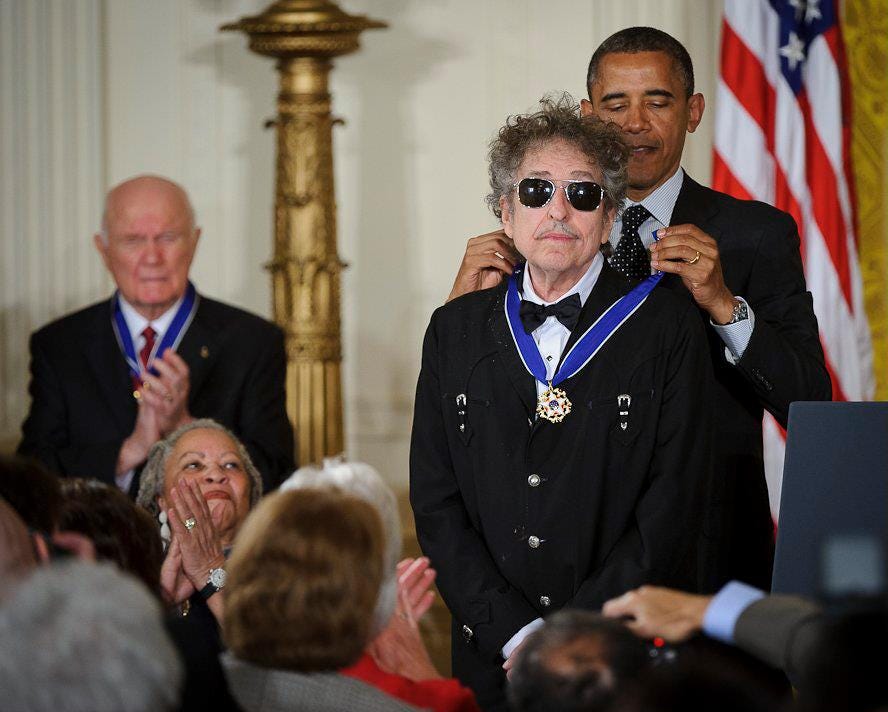
Obama’s fandom has only grown since then. For several years he has shared an annual playlist, and he regularly includes Dylan selections: e.g., “Tombstone Blues” (2015), “The Times They Are A-Changin’” (2020), “I’ll Be Your Baby Tonight” (2021). Dylan also received major praise from the President and the Boss in their 2020 podcast, published as a book in 2021 under the triple-title Renegades: Born in the U.S.A: Dreams, Myths, Music. When the subject of great protest songs came up in the fourth episode, Obama’s first pick was “Maggie’s Farm.” When the topic turned to American heroes, Springsteen nominated Dylan, and Obama seconded that emotion: “Dude, you can’t argue with Dylan. And he keeps on going! He’s a little bit like Picasso in the sense that he will just come up with different phases, and he just keeps on cranking out innovation. He seems to do it for himself as much as for anybody else.” Springsteen added, “He’s an artist. He’s doing what he’s got to do. That’s all.” “He’s this font of creativity,” concluded Obama (274).
The respect is mutual. Dylanologists will be familiar with his comments on the night of Obama’s election. On 4 November 2008, Dylan was playing in Minneapolis. Before launching into the concert’s final song, “Blowin’ in the Wind,” Dylan remarked from the stage about the evening’s historical significance. He pointed out that bassist Tony Garnier was wearing an Obama pin. Then he reflected, “Me, I was born in 1941. That was the year they bombed Pearl Harbor. I’ve been living in a world of darkness ever since. But it looks like things are gonna change now.”
Dylan’s most extensive comments about Obama came a year later in his 2009 interview with Bill Flanagan. Asked his impressions of the new president, Dylan demonstrated that he had done his homework. His fascination with Obama was kindled by reading Dreams from My Father. Dylan’s unconventional take on the book anticipates his colorful riffs in The Philosophy of Modern Song, distilling down Obama’s background into a condensed, dizzy, eccentric potion:
He’s like a fictional character, but he’s real. First off, his mother was a Kansas girl. Never lived in Kansas though, but with deep roots. You know, like Kansas bloody Kansas. John Brown the insurrectionist. Jesse James and Quantrill. Bushwhackers, Guerillas. Wizard of Oz Kansas. I think Barack has Jefferson Davis back there in his ancestry someplace. And then his father. An African intellectual. Bantu, Masai, Griot type heritage – cattle raiders, lion killers. I mean it’s just so incongruous that these two people would meet and fall in love. You kind of get past that though. And then you’re into his story. Like an odyssey except in reverse. (Flanagan)
There is a lot to admire about Barack Obama the man. But since I’m comparing him to a groundbreaking, shape-shifting artist, I should emphasize that there’s also a lot to admire about him as a writer, patterns and sensibilities highly compatible with Dylan’s own art. In my book on Time Out of Mind, I wrote extensively about the importance of dreams in Dylan’s work, so I won’t repeat myself here. Suffice it to say that Dylan found a fellow dreamer in Obama. As with Dylan, dreams work on multiple levels for Obama. Dreams come freighted with heavy baggage: weighed down with the broken promises of the American Dream, yet buoyed up by the hopeful aspirations of King’s “I Have a Dream.” From an early age, Obama consumed images from the civil rights movement to feed his zeal for community organization:
Such images became a form of prayer for me, bolstering my spirits, channeling my emotions in a way that words never could. They told me (although even this much understanding may have come later, is also a construct, containing its own falsehoods) that I wasn’t alone in my particular struggles, and that communities had never been a given in this country, at least not for blacks. Communities had to be created, fought for, tended like gardens. They expanded or contracted with the dreams of men—and in the civil rights movement those dreams had been large. (134)
Note how Obama believes in trying to make these big dreams come true, but he also harbors skepticism about his idealistic tendencies, suspicious that he is just clinging to a myth, a pipe dream, “a construct, containing its own falsehoods.”
Obama vividly recalls a specific moment of disillusionment in Dreams from My Father. He attended a contentious talk given in Harlem by Kwame Ture, formerly known as Stokely Carmichael, the SNCC leader who became a leading voice in the Black Power movement. The event devolved into open hostility, prompting young Obama to second-guess his hopes about community building as naively misguided. Look at how skillfully he interweaves multiple threads of dream imagery into this memory:
It was like a bad dream. I wandered down Broadway, imagining myself standing at the edge of the Lincoln Memorial and looking out over an empty pavilion, debris scattering in the wind. The movement had died years ago, shattered into a thousand fragments. Every path to change was well trodden, every strategy exhausted. And with each defeat, even those with the best intentions could end up further and further removed from the struggles of those they purported to serve. Or just plain crazy. (140)
This bad dream transports him from New York to Washington, from the 1980s to the 1960s, from hope to despair. In the absence of the father of the non-violent civil rights movement, the keepers of the dream allowed it to turn into a nightmare. No answers blowin’ in this wind: only confusion, recrimination, and shattered debris, as if the March on Washington were only a delusional fantasy. He reminds me here of Yeats, reassessing his nationalist dreams after the wake-up call of the Irish Civil War:
We had fed the heart on fantasies,
The heart’s grown brutal from the fare;
More substance in our enmities
Than in our love. (Yeats 205)
Obama does a beautiful job of connecting his personal search for belonging and acceptance with the historical sweep of African American experience. I have written elsewhere about Dylan’s penchant for allegory, where he takes personal songs about characters and relationships, and extrapolates them into larger religious or historical commentaries. For example, consider how he turns the central couple’s conflict in “Caribbean Wind” into a meditation on immigration and the transatlantic slave trade. Or consider how he uses each verse of “Mississippi” to reflect chapters in African American history, including the Middle Passage, Jim Crow, and the Great Migration. I wouldn’t go so far as to label Dreams from My Father as allegory. But Obama does recognize that his coming-of-age narrative is highly emblematic, and he tells his personal story as representative of larger African American struggles and dreams. Like Dylan, he sometimes tells this American story through song.
Chapter 5 is my favorite in Dreams from My Father. Young Obama begins the chapter lost and lonely, evoking nocturnal reveries that feel right at home with similar settings in Dylan’s “One Too Many Mornings” and “Visions of Johanna.” The chapter begins: “Three o’clock in the morning. The moon-washed streets empty, the growl of a car picking up speed down a distant road. The revelers would be tucked away by now, paired off or alone, in deep, beer-heavy sleep.” But the sounds inside the author’s mind won’t let him rest, so he seeks companionship in song: “And now just the two of us to wait for the sunrise, me and Billie Holiday, her voice warbling through the darkened room, reaching toward me like a lover. ‘I’m a fool … to want you / Such a fool … to want you’” (92).
Billie Holiday sings “I’m a Fool to Want You,” composed by Frank Sinatra, Jack Wolf, and Joel Herron. YouTube video posted by Official Billie Holiday.
It’s a great song, as Dylan well knows. You will recall that Dylan released a trilogy of American standards several years ago, with special emphasis on songs by Frank Sinatra. The first album was Shadows in the Night, and the first song on it was “I’m a Fool to Love You.” Both Dylan and Obama recognize a mood-setter when they hear it. In Dylan’s case, he may have highlighted “I’m a Fool to Love You” because Sinatra is also credited as a co-author of the song.
Obama has other agendas in mind. He strategically places the song at the crossroads of an identity crisis. As a young Black man in America, he knows how it feels to have no direction home like a complete unknown. He struggles to find a place where he fits in, where he belongs. He chooses a song that speaks to those feelings in ways the songwriters might never have anticipated. Sung by Sinatra, “I’m a Fool to Love You” is a lovesick plea directed toward a woman who keeps jilting the singer while he keeps coming back for more. Sung by Holiday, listened to by young Obama, and written about by a more mature Obama, “I’m a Fool to Love You” lands differently. The “you” in the song might just as well be America, who keeps promising liberty, equality, justice, and dignity, but then keeps dashing the dreamer’s hopes.
Time and time again I said I’d leave you
Time and time again I went away
But then would come the time when I would need you
And once again these words I’ll have to say
I’m a fool to want you
I want you soooo baaad. But you don’t want me. Still, the dream persists. Obama returns to Billie Holiday’s song at the end of the chapter, hearing something he missed before: resilience and endurance. “I picked up the refrain, humming a few bars. Her voice sounded different to me now. Beneath the layers of hurt, beneath the ragged laughter, I heard a willingness to endure. Endure—and make music that wasn’t there before” (112). Young Obama would endure as well. He got out of his funk, strengthened his resolve, heard his calling, and found his way.
His way led to Chicago. Again, Obama is conscious of how his personal story is emblematic of African American experience, specifically the Great Migration: “And as I drove, I remembered. I remembered the whistle of the Illinois Central, bearing the weight of the thousands who had come up from the South so many years before; the black men and women and children, dirty from the soot of the railcars, clutching their makeshift luggage, all making their way to Canaan Land” (145). “I was raised in the country, I been workin’ in the town / I been in trouble ever since I set my suitcase down,” as the singer puts it in “Mississippi.” Like Dylan, Obama channels the experiences of others to situate himself within the larger arc of history. In Dreams from My Father, he describes this process like a form of transfiguration or alchemy, allowing him to absorb the Chicago community he plans to serve: “I made a chain between my life and the faces I saw, borrowing other people’s memories. In this way I tried to take possession of the city, make it my own. Yet another sort of magic” (146).
Obama and Dylan are kindred spirits in this regard, displaying an uncanny talent for borrowing other people’s memories and perspectives. In his new book Folk Music: A Bob Dylan Biography in Seven Songs, Greil Marcus singles out empathy as Dylan’s superpower: “‘I can see myself in others,’ Bob Dylan said in Rome in 2001, speaking to a crowd of journalists, and if there is a key to his work from now back to its start, that may be it. The engine of his songs is empathy: the desire and the ability to enter other lives, even to restage and reenact the dramas others have played out, in search of different endings” (Marcus 5). Zadie Smith uses a different framework to describe Obama’s likeminded gift, drawing upon a scriptural reference to the Pentecost. She calls it speaking in tongues.
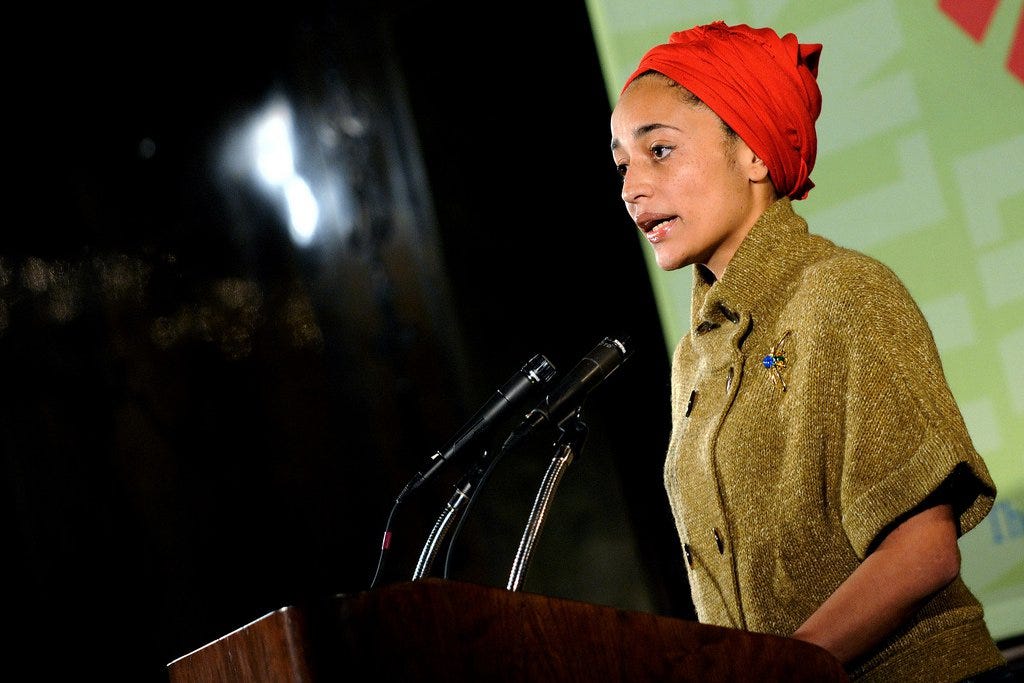
In her 2008 NYPL lecture “Speaking in Tongues,” Smith embosses Dreams from My Father with her literary stamp of approval, informing her audience of book lovers that they have just elected a damn fine writer as President of the United States.
In Dreams from My Father, the new president displays an enviable facility for dialogue, and puts it to good use, animating a cast every bit as various as the one James Baldwin—an obvious influence—conjured for his own many-voiced novel Another Country. Obama can do young Jewish male, black old lady from the South Side, white woman from Kansas, Kenyan elders, white Harvard nerds, black Columbia nerds, activist women, churchmen, security guards, bank tellers, and even a British man called Mr. Wilkerson. (182)
Obama’s magpie talents serve him well as a writer, and Smith sees enormous political application for this gift as well: “This new president doesn’t just speak for his people. He can speak them” (182).
Smith shares her own youthful experience with multiple voices. She came from a multiracial family in a working-class London neighborhood before moving off to university at Cambridge, exchanging her old accent for a new one. Smith describes this exchange as a loss, an erasure of her old voice and sacrifice of her former self. But that’s not at all what she hears in Obama’s vocal versatility. “The tale he tells is not the old tragedy of gaining a new, false voice at the expense of a true one. The tale he tells is all about addition. His is the story of a genuinely many-voiced man. If it has a moral it is that each man must be true to his selves, plural” (183).
Riffing off the title Dreams from My Father, Smith describes Obama, and herself, as native-born residents of Dream City. Given her description, it sounds like Dylan could be a naturalized citizen of Dream City, too:
It is a place of many voices, where the unified singular self is an illusion. Naturally, Obama was born there. So was I. When your personal multiplicity is printed on your face, in an almost too obviously thematic manner, in your DNA, in your hair and in the neither this nor that beige of your skin—well, anyone can see you come from Dream City. In Dream City everything is doubled, everything is various. You have no choice but to cross borders and speak in tongues. (184)
Dreamers from Dream City are always morphing into new selves, donning masks and speaking in different voices. This capacity for multiplicity and plurality is a virtue for artists. But what about for politicians and presidents?
Smith acknowledges that, among his detractors on both the left and the right, Obama’s facility for shifting identities and voices has been viewed with suspicion, suggesting that he is at best inauthentic, at worst a fraud. Obviously, Dylan has faced similar accusations throughout his career for much the same reasons. “How can the man who passes between culturally black and white voices with such flexibility, with such ease, be an honest man? How will the man from Dream City keep it real? Why won’t he speak with a clear and unified voice?” (Smith 186-87).
This might be a good place to note that Zadie Smith is familiar with Dylan’s work and counts herself a fan. In 2013 she was on the BBC radio program “Desert Island Discs,” where guests select songs they’d want to take with them if stranded on a desert island. One of Smith’s selections was Dylan’s 1964 song “To Ramona.”
“To Ramona” is essentially a song about the pressures felt by an artist—in this case Bernice Johnson Reagon, but by extension also Dylan himself—to conform to others’ expectations by speaking and singing “with a clear and unified voice,” a singular voice designed to advance a consistent political agenda.
But it grieves my heart, love
To see you tryin’ to be a part of
A world that just don’t exist
It’s all just a dream, babe
A vacuum, a scheme, babe
That sucks you into feelin’ like this
If you think that citizens of Dream City can be reduced to just one identity and stay on message with a unified voice, then you must be dreamin’.
“For reasons that are obscure to me,” Smith observes, “those qualities we cherish in our artists we condemn in our politicians. In our artists we look for the many-colored voice, the multiple sensibility” (189). Interestingly, when Smith looks for the ideal manifestation of this artistic ideal, she turns not to Dylan but to one of the artists he admires most: Shakespeare.
Shakespeare’s art, the very medium of it, allowed him to do what civic officers and politicians can’t seem to: speak simultaneous truths. […] In his plays he is woman, man, black, white, believer, heretic, Catholic, Protestant, Jew, Muslim. He grew up in an atmosphere of equivocation, but he lived in freedom. And he offers us freedom: to pin him down to a single identity would be an obvious diminishment, both for Shakespeare and for us. (190)
“Amen and hallelujah!” respond Dylan and Obama in chorus.
Of course, artists have never been immune to charges of overstepping acceptable boundaries. In cultural criticism this prohibition usually goes by the name “appropriation.” If you attempt to speak in other people’s voices about experiences not your own then you enter an ethical minefield and become vulnerable to charges of appropriation. Dylan’s loves and thefts are well known to readers of Shadow Chasing, as is his unabashed determination to keep swerving out of his lane by channeling the perspectives of others. The many-voiced, multi-selved Obama defends the right to defy the strict border patrols of self-appointed cultural gatekeepers. Here is what he recently had to say on the subject in Renegades:
This whole issue of cultural appropriation—I have to say I am not a believer in narrowly defining who gets to do what. I think we steal from everybody, everywhere. That’s the nature of humanity. That is the nature of culture. That is how ideas migrate. That’s how music gets created. That’s how food gets created. I don’t want us to be thinking that this way is for that person, and that way is for the other person. (272)
He does acknowledge and denounce the very real and persistent problem of economic exploitation of artists of color. That important caveat aside, he doubles down on his defense of loving theft: “I’ve got no problem with white artists doing Black music because I don’t think there’s such a thing as simply, exclusively Black music or white music or Hispanic music” (272).
Near the end of her lecture, Smith offers a four-stage theory about the developmental process through which one develops fluency for “speaking in tongues.” Again, she is using Obama as her case study, but it’s remarkable how snugly her theories fit Dylan’s art as well:
In this first stage, the voice, by no fault of its own, finds itself trapped between two poles, two competing belief systems. And so this first stage necessitates the second: the voice learns to be flexible between these two fixed points, even to the point of equivocation. Then the third stage: this native flexibility leads to a sense of being able to ‘see a thing from both sides.’ And then the final stage, which I think of as the mark of a certain kind of genius: the voice relinquishes ownership of itself, develops a creative sense of disassociation in which the claims that are particular to it seem no stronger than anyone else’s. (192)
This is Obama’s political genius: to serve as medium for giving voice to the lives, concerns, and hopes of others. As he pointed out in Renegades, “That’s what you discover when you’re running for president—people would lift you up. It’s not you. You’re channeling their energy. Their hopes. Their power. Their resilience” (257). This is part of Dylan’s artistic genius, too.
Lately we have become so familiar with referring to Dylan’s capacity to “contain multitudes” that the phrase is on its way to becoming a cliché. Smith offers a different but equally insightful passage, perhaps threadbare from overuse among Shakespeareans, but still salvageable among Dylanologists. I am referring, via Smith, to Keats’s notion of “negative capability”: “At once it struck me, what quality went to form a Man of Achievement especially in Literature and which Shakespeare possessed so enormously—I mean Negative Capability, that is when man is capable of being in uncertainties, Mysteries, doubts, without any irritable reaching after fact and reason” (qtd Smith 190).
Let me bring it back home by way of dreams and fathers. The sixth chapter of the Renegades book is called “Wrestling with Ghosts.” The title is taken from Springsteen’s description of wrestling for years with the ghost of his father, a battle he eventually learned to stop fighting. “Ghosts haunt you. Ancestors walk alongside you and provide you with comfort and a vision of life that’s going to be your own. My father walks alongside me as my ancestor now” (208). Dylan also invokes ancestors in The Philosophy of Modern Song. Trying to understand how John Trudell found the strength to endure horrific suffering and loss to survive and create art, Dylan imagines drawing sustenance by conversing with ancestral spirits: “You’ll go into the mythic land of rebirth, stare up into the mirror of the night sky and talk to your ancestors” (196). It’s valid and useful to think of the entire book as Dylan’s conversation with his musical ancestors. But Dylan has also become one of those ancestors for subsequent generations. I think that’s how Obama regards him.
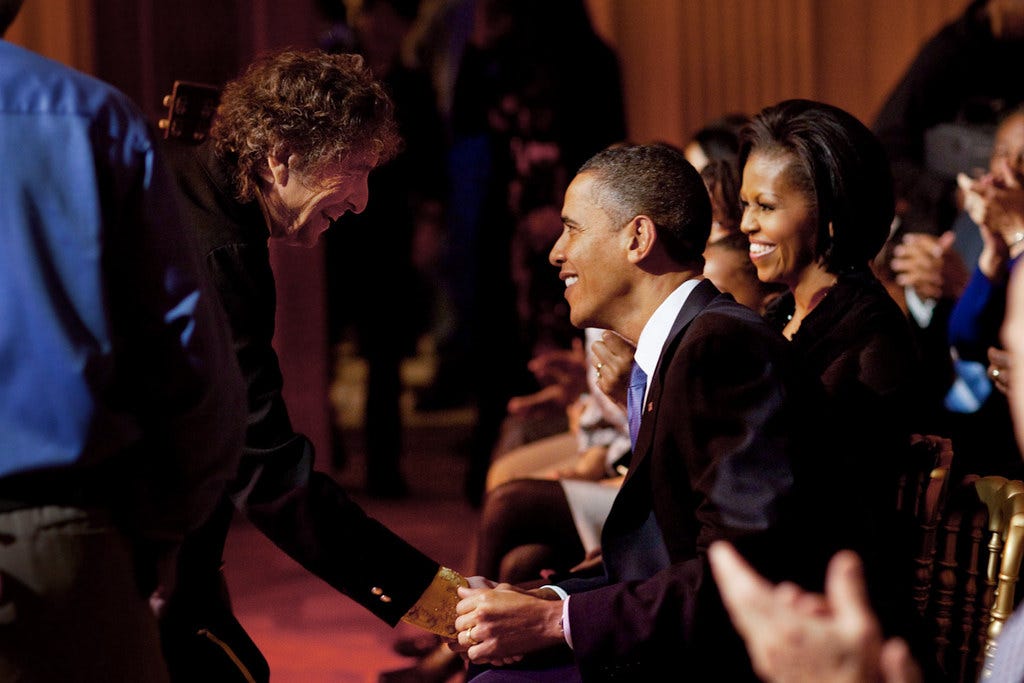
The former president was born in 1961, the same year Dylan arrived in New York and recorded his first album. The two men probably don’t know each other very well in their personal lives, but they do speak the same languages and share many of the same dreams. When Obama writes about “dreams from my father,” he has multiple fathers in mind. King and Lewis are certainly among them, but there are others.
When Barack Obama speaks with his ancestors, I believe that conversation includes Bob Dylan.
Works Cited
Dylan, Bob. “Mississippi.” “Love and Theft.” Columbia, 2001.
---. The Philosophy of Modern Song. Simon & Schuster, 2022.
---. “To Ramona.” Another Side of Bob Dylan. Columbia, 1964.
Flanagan, Bill. “Interview with Bob Dylan – Part 3” (16 April 2009). Rpt. The Beat Patrol. https://beatpatrol.wordpress.com/2009/04/16/bill-flanagan-interview-with-bob-dylan-part-3-2009/.
“I’m a Fool to Want You.” Written by Frank Sinatra, Jack Wolf, and Joel Herron. Performed by Billie Holiday. Lady in Satin. Columbia, 1958.
Marcus, Greil. Folk Music: A Bob Dylan Biography in Seven Songs. Yale University Press, 2022.
Obama, Barack. Dreams from My Father. 1995. Three Rivers Press, 2004.
---. A Promised Land. Crown, 2020.
---. “Remarks by the President at Presidential Medal of Freedom Ceremony. Obama White House Archives (29 May 2012), https://obamawhitehouse.archives.gov/the-press-office/2012/05/29/remarks-president-presidential-medal-freedom-ceremony.
Smith, Zadie. “Speaking in Tongues.” The Best American Essays 2010, edited by Christopher Hitchens. Houghton Mifflin, 2010, pp. 179-94.
Springsteen, Bruce, and Barack Obama. Renegades: Born in the U.S.A: Dreams, Myths, Music. Crown, 2021.
Yeats, W. B. “Meditations in Time of Civil War.” The Collected Poems of W. B. Yeats, edited by Richard J. Finneran. Scribner, 1989.




Thanks, this is a fine article. I like what Obama said about Dylan in his Rolling Stone interview (14 October 2010):
"Here's what I love about Dylan: He was exactly as you'd expect he would be. He wouldn't come to the rehearsal; usually, all these guys are practicing before the set in the evening. He didn't want to take a picture with me; usually all the talent is dying to take a picture with me and Michelle before the show, but he didn't show up to that. He came in and played "The Times They Are A-Changin'." A beautiful rendition. The guy is so steeped in this stuff that he can just come up with some new arrangement, and the song sounds completely different. Finishes the song, steps off the stage--I'm sitting right in the front row--comes up, shakes my hand, sort of tips his head, gives me just a little grin, and then leaves. And that was it--then he left. That was our only interaction with him. And I thought: That's how you want Bob Dylan, right? You don't want him to be all cheesin' and grinnin' with you. You want him to be a little skeptical about the whole enterprise."
Fantastic Graley - Thanks so much for writing and sharing this!